| We travelled westward from Port Townsend across the top of the
Olympic National Park. We passed through Port Angeles and headed for the
west coast, the Pacific Ocean, and a camp site on the Quilleute Indian
Reservation at a place called La Push. We expected the west coast to be
full of people but it was empty. Admittedly it was not the best site in the
world, Indian reservations seem to be universally depressing places but we
somehow expected a bit more. | 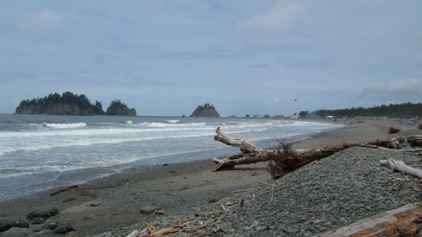 |
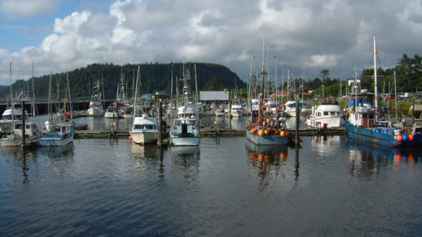 | The beach was
fine except that it was covered in driftwood. To be more precise it was
covered in dead trees which had been washed up, and some of these were HUGE.
They could have been there since time began. There was a small harbour
with a few fishing boats but not really a marina. We were surprised given
that we were only some 120 miles from Seattle. There was a coastguard
presence and some boats from the wildlife protection services which are very
prevalent here. |
| The harbour estuary was a haven for seabirds, in particular large numbers of brown pelicans. We also saw a pair of bald-headed
eagles fishing which was quite something. We think the island in the picture
contains a lighthouse and certainly a foghorn. But the board in the harbour
says only the 'Ancestors' live there now. We also watched seals swimming
in the estuary. | 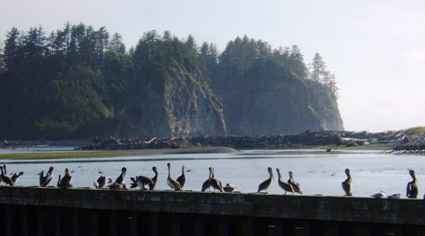 |
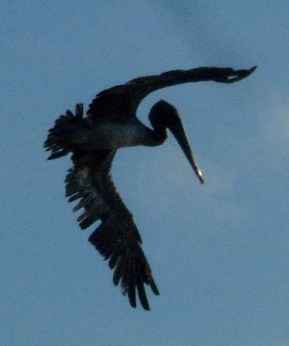 | The pelicans are
really quite ancient birds on the evolutionary ladder and to look at them in
flight you can see how they might be related to pterodactyls!. However they
are very graceful to watch as they glide inches from the sea's surface.. |
| Just an example of the size of trees on the beach. This root
system is at least 15ft high and the tree must have been over 50ft long. It
is quite interesting to note how the logs have been quite rounded by their
battering during their sea journey from wherever they came from. | 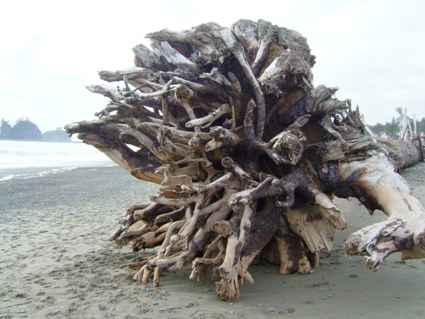 |
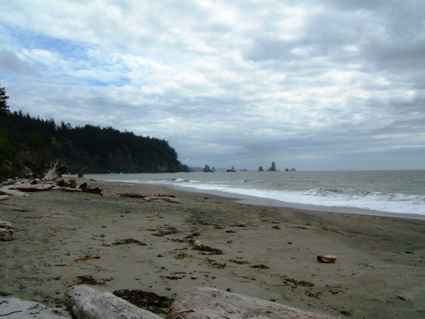 | There were other
beaches in the area and we visited one which was only reached by a two mile
trek through the 'rainforest'. The path was well made, gravelled and marked.
There were twelve cars at the car park but we saw no one on the beach. One
wonders where they went because you do not leave the path in forest like
this - it is quite impassable. |
| Washington state, west of the Cascades, is known for being wet.
This area gets twelve feet of rainfall a year - and we experienced our
share! This, with its temperate climate, gives rise to rainforest quite
unlike the other forests we had seen so far. This fallen tree is a good example
with its 'nursery' of young ferns, mosses and other epiphytic plants. The
forest floor is absolutely
covered in ferns and seedling trees. And everything is damp. |  |
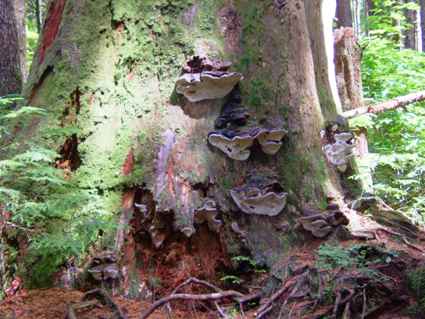 | Most of the old and dying trees also have a variety of fungal
growths, starting the recycling process.
Some of the fungi is
quite striking and colourful, This tree was covered in growths of one sort
or another.. |
 |
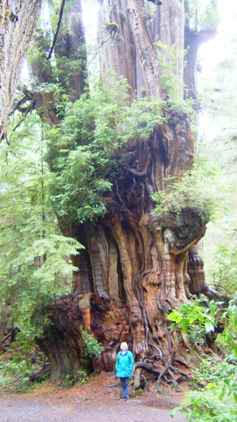 | Moving round
Olympic, south from La Push, we came across this Great Cedar. The top (some
50 ft above this picture) had gone but Jan gives some scale to the size of
the trunk. There were other trees in the general area which would have been
comparable in size. It is impossible to assess just how old these trees
might have been. A lot of the forested area is actively harvested and we
have seen signs saying when each area was last harvested and replanted and when
the next cycle is due. This is a long term process! (60 years+) |
| But the ocean seems to do its own version on the coastal strip.
There are many beaches, often made up from black volcanic ash (this is a
very volatile region and Mt St Helen is only some 100 miles away).
Universally they are littered with driftwood logs sometimes two and three
feet in diameter and all rounded off at the ends by the action of the
waves. | 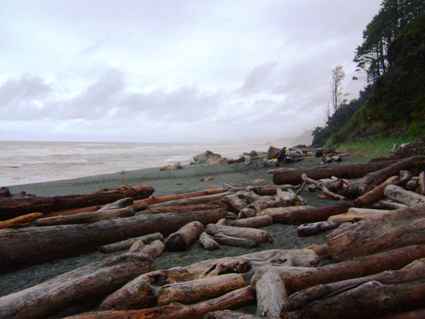 |
 | Looking back
from the beach you can see the edge of the rainforest just up the numerous
gullies where streams flow out to the sea. Although there is a narrow road
along the coast, it is pretty desolate back from there through the Olympic
National Park. Essentially there is nothing back from the coast for almost
100 miles. We were amazed at how empty this area is. Apparently the reason is that the sea is
actually quite cold because of the currents coming down from the Arctic - the
reverse of the Gulf Stream. And of course, no cellphone,
television or even radio signals unless you have satellite service. |
| So after two days of rain, we headed south and eastwards heading
back towards Seattle and civilisation. Passing through Aberdeen (pop 16000)
we found where all the logs end up. The steam in the background comes from
the pulp mills. We carried on a little further to a quiet site in Montesano
for the weekend. | 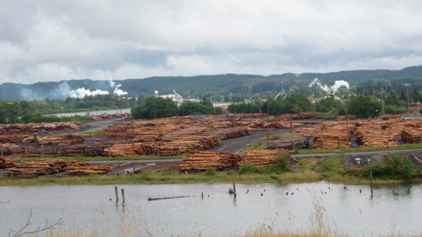 |
|